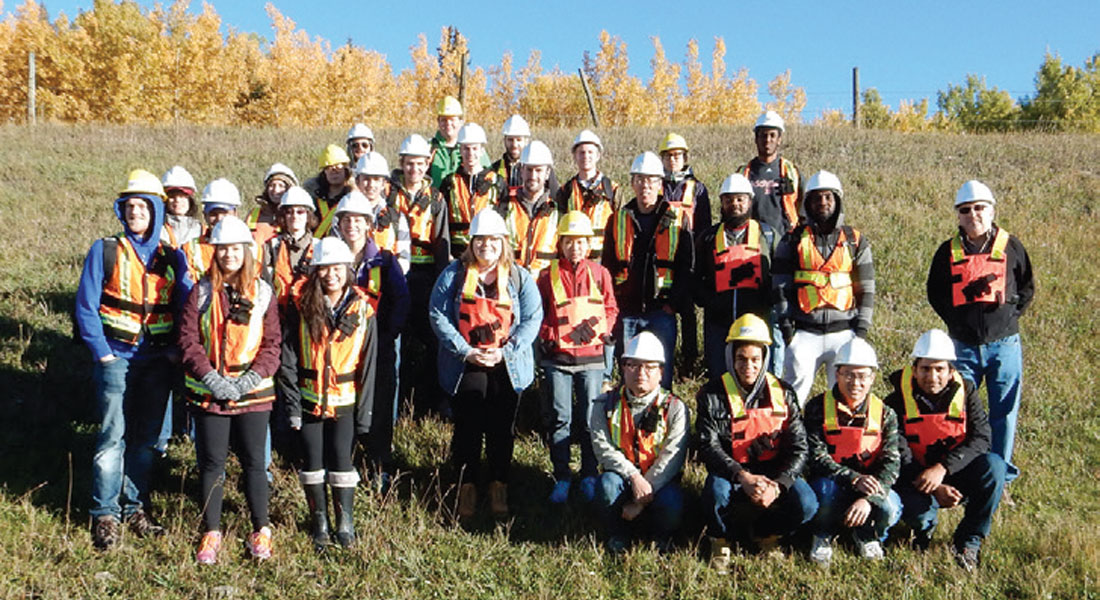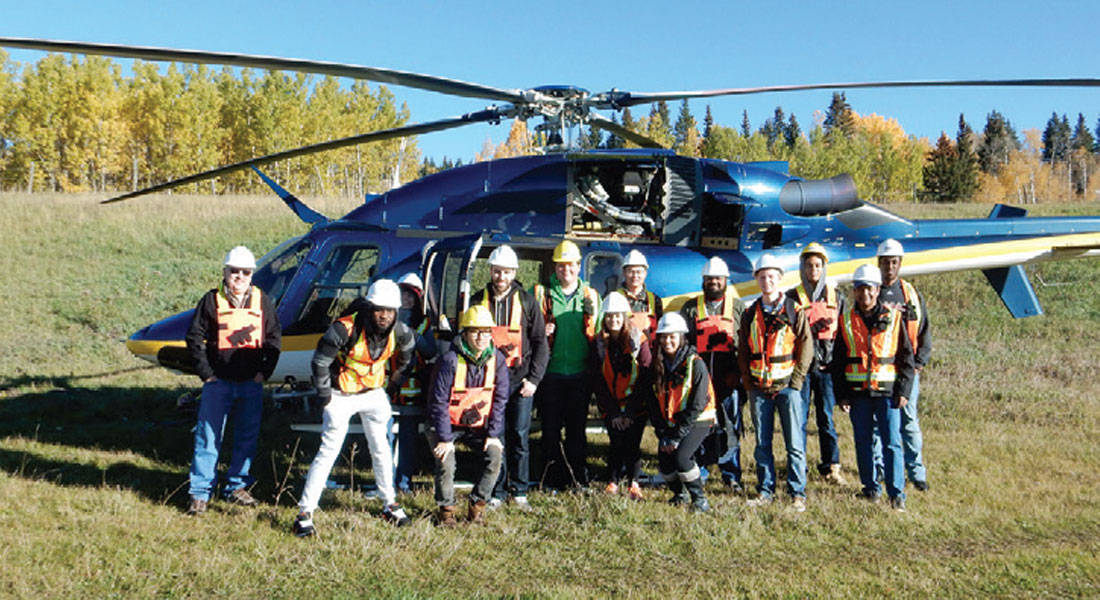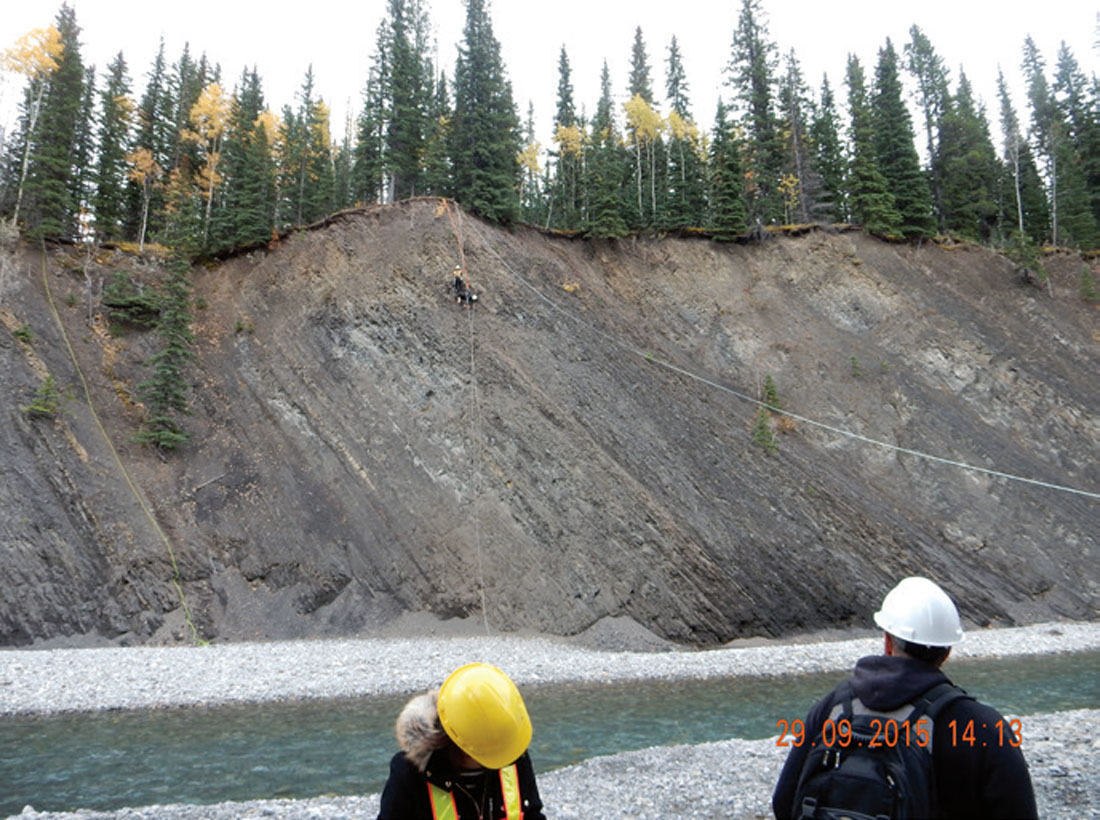Field Trip to CAGC’s 2015 Seismic in Motion (SIM)
“We must find time to stop and thank the people who make a difference in our lives.” JOHN F. KENNEDY
September 2015 was the eighth year that SAIT students in the GSIT Diploma program have attended the SIM Field Trips since the CAGC SIM tours started in 2003. The GSIT students learn by observing first-hand each acquisition station as set up and operated by seismic contractors.
The Geoscience Information Technology (GSIT) program at SAIT, formerly EIT and then EXPT, is a two year full-time Diploma program. The program has been in existence since its inception in 2000. Graduates of the program are employed in support roles to Geologists and Geophysicists as Geoscience data managers, technicians and technologists in various capacities. Several oil and gas companies such as Cenovus, CNRL, Statoil and Repsol as well as many others and Geophysical service companies such as WesternGeco, CGG and Hampson-Russell all have employed program graduates.
SIM Field Trip: September 30, 2015
With the dust having settled after a day of trekking from station to station in Waiparous Alberta, (northwest of Calgary) at the CAGC’s Seismic In Motion (SIM) field trip, I am left with a great need to find time “to stop and thank” the Canadian Association of Geophysical Contractors (CAGC) and especially the industry sponsors of the event. With the oil and gas industry in a downturn, to host a field trip such as SIM is in itself an accomplishment. The annual field trip is an invaluable learning experience for my students in the Geoscience Information Technology (GSIT) program at SAIT. The timing of the event couldn’t be better with classes for the new batch of students having commenced at the beginning of September. Be it a young, energetic high school graduate, or a mature student embarking on a new career direction, the insight gained by seeing seismic data acquisition first hand is beyond measure. My task as a Geophysics instructor is that much easier when my students already have vivid images of the various aspects of seismic data acquisition. Needless to say, for the students, being away from the campus in the great outdoors and, on top of that, not having classes, is definitely a treat. This year’s annual SIM field trip was my eighth in a row and even though it may feel like a case of “been there, done that”, I eagerly attend the field trip with my students so that I can appreciate their questions and concerns, as well as any doubts they might have about the future of Geophysics in the oil and gas industry.

This year we were blessed with incredible weather, which made the field trip that much more enjoyable. There was one common theme at each station we visited that was very evident to my students and me: those individuals who contributed their time and efforts to educate the uninitiated in the ways of the industry did so with great eagerness. Their sense of pride in their profession and the gladness to be able to share their career experiences with future geoscientists was all too evident. Equally understood by us was the attention given by field personnel to safety.
They welcomed questions from the students and from both me and our group guide, Neil Rutherford. A sincere word of thanks must be given to Neil for sharing his vast experience in the seismic industry and seismic data acquisition with my students.
Visiting the helicopter station made me realize how interested my students were in the science of aerodynamics. For some of them, being able to sit inside a helicopter, perhaps for the first time and imagine what it would be like fly it lit up their eyes. Listening to the veteran pilots tell their tales of experience and share their jargon for various circumstances was hilarious.

In a time when environmental awareness is at the forefront of our industry, the effort that acquisition companies spend to meet and exceed environmental regulations is admirable. Through their efforts the “acquisition footprint” is becoming nearly invisible.
My students and I enjoyed the presentation of Dany MacDonald of Austin Powder, especially with his references to “Austin Power”. His demonstration of the destructive power of just one gram of explosives in a detonation cap using a beer bottle that may have been, as he jokingly put it, emptied not long earlier, is definitely a crowd pleaser.
“Education is the movement from darkness to light”. ALLAN BLOOM
Having one of my students “push the red button” and detonate the cap was simply great. I am also glad to realize the safety measures and accountability in place when handling and transporting explosive in Canada.
When I mention to my students the depth of a dynamite shot hole in class, it can feel bland, but when the driller explains how it is done and how he prefers to work at -20°C, it gives a whole new meaning to shot hole drilling. Surveying has definitely come a long way in the last few decades: the technological advancements are simply amazing thanks to the constellation of satellites that are at work in ensuring the accuracy of survey points.

Often my students ask if they should pack a lunch, but I can gladly say that it will be provided by the event organizers. The free meal only adds to their gratitude for the experience that they receive, free of charge to them and to SAIT. For me, the midday break is a chance to enjoy the lunch and prepare for the “main event” in the afternoon.
The stations we visited in the afternoon were more critical to my teaching seismic data acquisition to my students. First, we visited the CSEG booth where the students were shown how seismic energy propagates in the subsurface. The software on a laptop that recorded seismic waves from sound generated in the booth impressed the students because they could actually see P-waves and S-waves being generated and recorded. With that, they have proof that what I taught them in class was actually true. Seeing a seismic vibrator truck in action and feeling the low frequencies being injected into the ground is the best way to describe “vibroseis” as a seismic energy source. Each year I hope there will be a vibroseis at the field trip site because the sweeping demo is an invaluable one. The rest of the afternoon was spent observing the other aspects of seismic data acquisition such as the type of geophones used in the field and writing the data to tape in the “dog house”.
The last station about rescue operations in steep terrain gave a good appreciation for the importance of the safety of all field workers and the extent to which acquisition companies go to ensure safety is a priority.
The day came to a conclusion with three demos: mulching of a felled tree, helicopter rescue and transporting of an injured field worker (in this case a mannequin) and the use of explosives which, without a doubt, was the highlight of the field trip. The crisp, sharp sound of a 2 kg explosive going off cannot be described in a classroom. This was followed by a 4 kg shot and a shot that demonstrated what a “blowout” looks like. The students’ inspiration very evident from their “oohs” and “aahs”.
With another SIM field trip in the history books it was time to head back to Calgary. The event evaluation completed by my students and their feedback back in the class at SAIT left me with no doubt that everyone in the class thoroughly appreciated the amazing opportunity to see seismic data acquisition first hand.
I look forward to the next SIM field trip with a new batch of future geoscientists.
Photos Courtesy: Patricia Castillo (SAIT Linux Instructor)











Share This CSEG Report